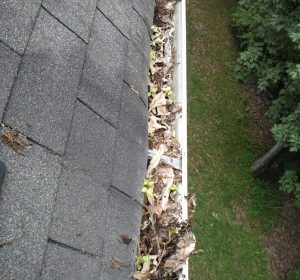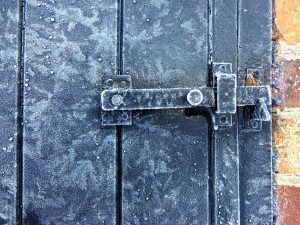Jump to:
December is on the doorstep, and the cold weather is already here in force. The winter months can make your garden look lovely at times, with frosty grass and layers of snow. But it can also cause havoc.
If you’ve not yet considered preparing your shed or garden building for winter, now’s the time to get started. To help keep your shed safe during the colder months, we’ve created this simple, informative guide that covers all aspects of protecting your prized garden building.
We’ll start off by taking a quick look at all the dangers winter weather can pose, before checking off all the measures you can take to keep your shed safe.
While we’ll be focusing on wooden sheds in this guide, all of these tips can be used for other kinds of garden buildings such as log cabins, summerhouses, and even children’s playhouses!
Winter’s coming, so let’s get ready for it!

Which type of shed is best for winter?
Between wooden, metal and plastic sheds, wooden sheds offer the most insulation against the cold. This is because wood has naturally insulating qualities, and the walls on sheds are typically thicker than the panels of their metal and plastic counterparts. However, wood does expand and contract with temperature changes, which can lead to gaps forming that will require patching. It also requires treatment in advance to protect it against moisture.
In contrast, metal is a thermal conductor, so a metal shed is likely to let the cold go straight through it over the winter. That said, high quality galvanised steel sheds will stand up to the cold weather conditions without any need for maintenance.
Plastic sheds offer a good middle ground; they stay slightly warmer than metal sheds in cold weather, and quality brands such as BillyOh are extremely heavy duty, so they will be undamaged by wind and wet conditions. They are an excellent option for both storage and workshop solutions.
Dangers of Winter Weather
The cold days of winter can cause serious problems for garden buildings, especially when temperatures dive below freezing. Winter storms are just as dangerous, with high winds and snow blizzards having the potential to cause irreparable damage.
To make sure you’re fully prepared for either of these, let’s run through the kinds of damage you might face through the season.
- Water damage. Water seeping into the shed can cause water rot or decay, no matter where it gets in. If the water freezes it can cause structural damage, too.
- Wood or structural damage. When exposed to cold temperatures and high winds, the boards of your garden building might become wet and warped. They might suffer damage from collisions with flying debris.
- Roof damage. Again, high winds, debris, or falling trees can cause fatal damage to unprotected roofs. Accumulated snow can also cause a collapse or breakages.
- Frost damage. Freezing temperatures and ice can damage garden building fixtures such as windows, hinges, or locks by causing the materials to shrink or warp.
This list makes it clear: winter can be a dangerous time for garden buildings. The good thing is that there’s not much preparation required to protect your shed from all but the most extreme of circumstances!
Every measure we suggest in this guide will be used to protect your shed from at least one of these types of damage. If you follow each step, you’ll have full winter protection.

Start With A Quick Survey
Before taking any of the measures we’re going to go through below, it’s a good idea to give your shed or garden building a once-over.
Check the base, windows, roofing, and structure for existing damage. Anything that is already broken will only become worse during cold weather, so fix any of these issues as soon as possible.
Make sure you also do a full inspection of the interior. You may need to move tools/stored objects to check everywhere, but it’s worth doing so. Again, fix any glaring issues immediately. Doing this will ensure that you won’t come across any unexpected problems when winter is here in full!
Now let’s move on to taking preventative measures.
Waterproofing

One of the best ways to protect your shed from inclement weather is by waterproofing it. This will ensure that no water gets inside, preventing water damage such as rot as well as frost damage from freezing water.
Luckily for you, we already have a complete guide for waterproofing a shed waiting in the wings!
Read all about how to waterproof your shed here.
But, for those of you in a hurry, we’ll run through a few key tips and tricks right here.
The key to waterproofing is stopping water from getting inside the shed. This means protecting the shed from water wherever it might get inside. Cover any holes in the roof, secure the foundations, fix any gaps in the structure of the building – these occur most often around joints and fittings.
Once you’ve sorted out the gaps and holes, install a bit of ventilation so that any water that does get in won’t make the building damp. There are a number of extra steps you can take to ensure your shed is fully waterproof – simply visit our guide to learn more.
Protect The Roof

When preparing for bad weather, the roof of any garden building is one of the most important things to pay attention to. With the roof, things are either completely fine…or in complete disaster. If the roof breaks, you’ve got a real issue and – trust us you don’t want that kind of problem on your hands.
Getting your roof ship-shape and keeping it that way isn’t a one-stop job. There’s a few things to do and watch out for throughout winter to maintain your shed roof.
Repair any holes and fit new felt
Making sure your roof is undamaged, water-tight, and wind-proof is a great way to prevent roof damage as well as water damage.
Check for any gaps in the roof or the felt. If the felting or boards have any holes, big or small, you need to get rid of them immediately. In fact, if you find any it’s a good idea to inspect for damage that might have already happened.
You can make temporary repairs to the roof using wooden boards. Simply fit them over the gap with a couple of nails and you have a short-term fix. However, you’ll eventually need to fit new felt.
If you’re particularly worried about the condition of the felt you should also consider replacing it with a new sheet.
Clean out your guttering

If your shed or garden building has any guttering, make sure it is fully cleaned out before winter. In particular, get rid of any leaves stuck in there.
Clogged guttering can prevent proper water drainage, which can lead to build-ups of water and, eventually, water ingress. Removing any debris will prevent water damage. It also helps to stop frost damage since there won’t be water build-ups that could freeze.
Cleaning guttering is a simple task when it comes to garden buildings as they’re close to the ground and easily accessible. Get a pair of dirty gloves on and get right in there! It’s messy but worth it.
Clear away snow from the roof

This tip isn’t something to do now, but something to check on throughout winter.
Snow might look pretty on the ground, but it’s dangerous for shed and garden building roofs. Not only will it melt into lots and lots of water, causing potential water damage, but it is extremely dangerous when it accumulates. If too much snow builds up on your roof, it can become too heavy and cause serious structural damage – if not a collapse!
Prevent this by simply clearing any snow from the roof any time it collects there. Use a brush so you can reach higher and keep your hands dry.
As long as you keep on top of any snow, keep the guttering clean, and prepare your roof in the right way – you won’t have an issue with it.
Secure the Inside
This tip is actually about preparing what’s inside your shed, not the exterior, for the winter.
Harsh winds and tumultuous weather can shake your shed around more than you expect. In the middle of a particularly bad storm, this can cause the contents of the shed to move around or even fall over.
Heavy falling objects can not only break themselves and your other items, but they can also damage your shed and cause structural damage. That’s why it’s best to secure everything you’re keeping inside.
Make sure anything heavy or tall won’t fall over – or secure it to the floor if it looks risky. If you have items that are fragile or may easily break then consider bringing them into your house to keep them safe.
It’s also a good idea to prevent wind from getting inside by closing any gaps and caulking around the edges of your windows.
Oil Hinges and Locks

Cold temperatures can cause different materials to change their properties, as well as shrink or contract. Metal is particularly guilty of this – it contracts and makes itself smaller when cold.
This is dangerous for any metal fittings you have in or on your shed, especially those that are outside and exposed to the cold like hinges or padlocks. This shrinking can cause frost damage if the metal gets stuck.
You can’t stop them from shrinking in the cold, but you can ensure that things won’t break when they do. Simply apply a bit of oil to your hinges or locks so that they won’t get stuck when it’s cold.
A Final Coat of Protection
Consider safeguarding your shed by giving it a coat of protection before the cold settles in.
Paint the exterior of your garden shed with a coat of wooden preservative or wood stain and protector. Either of these products will protect the boards from any wood damage or water damage they might suffer from being exposed to wet and cold conditions. They’ll also make it look prettier!
The Roundup
Preparing your shed for winter isn’t all doom and gloom – in fact, it’s preventing exactly that! Just taking a few hours to prepare your shed before winter is here to stay can ensure it will be safe until springtime. Let’s run through those steps one last time.
- Waterproof your shed to ensure there is no water ingress and subsequent rot.
- Protect your roof by fixing any holes, fitting new felt, cleaning the guttering, and removing any build-ups of snow.
- Secure the shed’s contents to avoid breakages and structural damage.
- Oil hinges and locks and prevent frost damage to your metal fittings.
- Give it a coat of protection to ensure the wood boards are ready for winter!
Those are your five quick and simple steps for preparing your shed for winter. To further your knowledge, read this guide to sheds next!





